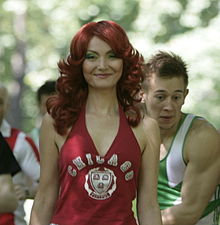Leskowicz Pawel Feminist Revolt Censorship of Womenã¢ââ¢s Art in Poland
| Katarzyna Kozyra | |
|---|---|
 Katarzyna Kozyra in 2007 | |
| Born | (1963-02-01) February i, 1963 Warsaw, Poland |
| Teaching | University of Warsaw University of Fine Arts in Warsaw Hochschule für Grafik und Buchkunst Leipzig |
| Awards | Paszport Polityki |
| Website | katarzynakozyra |
Katarzyna Kozyra (built-in 1963) is a Shine video artist. She studied German studies at the University of Warsaw (1985–1988). In 1993, she besides graduated from the Academy of Fine Arts in Warsaw where she studied sculpture and Hochschule für Graphik und Buchkunst in Leipzig. Kozryra received a Paszport Polityki award in 1997 as the most promising artist in Poland.[1] She has exhibited internationally since 1997, at venues including Brown University and Carnegie International in the U.Southward.
Her art was involved in a 1999 censorship incident in Poland. Her photo portrait of Slawomir Belina in a Warsaw exhibition in 2000 was also controversial for its declared eroticism, as his anus was in the center of the composition.[two] [three]
Since 2003 Kozyra has received a DAAD grant, and has developed a new form of performance involving operatic singing.[4]
In 1999, she represented Poland in the 48th Venice Biennale where she won an honorable mention and commendation for video installation "Men's Bathhouse".[ane] In September 2011 she received the Smooth Ministry of Civilization and National Heritage grant.
Creative activity [edit]

"Pyramid of Animals" was her 1993 graduate piece, which became a sensation and "object of fierce controversy" in Poland at the fourth dimension.[5] The slice consisted of the dissected and taxidermied animal bodies of a horse, dog, cat, and rooster and a video depicting the killing of the horse.[1] While quoting a theme from Grimm Brother's fairy tale The Bremen Boondocks Musicians, the work concerns human interest in industrial animal killing procedure and the normalization of murder when function of the nutrient concatenation.[v] [6] Information technology was too said that this piece wasn't merely, "a piece of work most animals, but a work about death, about killing, and their significance in nowadays day culture".[seven] Kozyra became known as a controversial creative person because of the notoriety with the installation, but too because of her other works: "Blood Relationship" (1995), "Olympia" (1996), "Bathhouse" (1997), and "Homo's Bathhouse" (1999).[8]
In "Olympia" (1996), Kozyra put her fight with cancer and the taboo of naked female bodies on display.[ane] As an attempt to restore nobility to an ailing, moribund torso by exposing social stereotypes of the aging female torso, Kozyra juxtaposed Édouard Manet's "Olympia" (1863), an image of a healthy, strong, and beautiful body, with her ain chemotherapy handling.[i] Information technology was a protest confronting the conventionalities that body illnesses or senility doom its owner to social invisibility. Included in the work are a photographic triptych of Olympia and a video of Kozyra's treatment. The first image shows Kozyra lying in the same pose as Manet'southward "Olympia", just her body is non meant to be the object of desire as with Manet'south work, but, instead is stake, hairless, and unhealthy. The 2nd image depicts Kozyra naked on a hospital bed– she is completely hairless and the effects of the chemotherapy are obvious. The third image shows an erstwhile adult female sitting on a bed – she is alone. Her torso is flabby and she has actually saggy breasts. Her confront is wrinkled all over and information technology seems that all her teeth are gone. At the same time she looks actually calm – like she would reconcile with her fate. The women in all the photographs have one thing in mutual – black ribbon wrapped around the neck to symbolizes mourning and to hearken back to the work past Manet. The well-nigh scandalous element is not presenting the female nude as itself, but presenting the reality of life, illness, and death; that the female trunk is not just a matter of dazzler and admiration of the male gaze.[ane]

"Bathhouse" (1997) considers similar subject matter. Kozyra'south intention was to show how women really appear in situation where nobody is looking and when they don't demand to follow dazzler canons. Kozyra was able to certificate this natural behavior past shooting her piece of work with a hidden video camera. Past doing this, she presented the female body as is and encouraged the viewers to go against their previous ideals and standards of beauty.[nine] Additionally, information technology was an allusion to the history of fine art, with works of Rembrandt and Jean Ingres opening and endmost the video.[one]
"Man'due south Bathhouse" (1999) was a confrontation with and continuation of "Bathhouse". Kozyra went into a men'south bathhouse with false penis fastened to her and a towel hung on her shoulders covering the breasts. Surprisingly she institute out, that men even when beingness lonely they nevertheless focus on their advent, peer at each other, and compare.
"The Rite of Spring" (1999-2002) was a video installation inspired past the choreography for Igor Stravinsky's 1913 ballet of the aforementioned proper noun. Kozyra used onetime dancers from the Polish National Ballet who were no longer able to dance for this work. Kozyra photographed the elderly subjects lying on the ground in dance positions and then animated their movements.[10]
Kozrya has been working on her "In Art Dreams Go True" series since 2003. The series of visual art, music, and performance is released in phases of the project, each every bit a separate work although they are intended to be combined in a characteristic film. In the work, Kozrya is "existence manipulated as she strives to fulfill her dream of becoming a "real woman" and an opera vocalist."[ane] In 2011, she received the Award of the Minister of Civilization and National Heritage of the Republic of Poland for her artistic accomplishments.
Controversy [edit]
Anda Rottenberg, Director of the Zachęta National Gallery of Art in Warsaw where Kozyra get-go showed "Bath business firm" in 1997 and who as well purchased the work, sparked off controversy by writing to Fine art Monthly in October 1998 and claiming that Kozyra's "Bathroom house" and artist Tacita Dean'due south 1998 "Gellert" were of the same subject: the most famous bathhouse in Budapest. Freely admitting that controversy helps in the promotion of a work, "Controversy around this work was in fact a very stimulating factor and at present as the months passed Bathroom house has come to be regarded as archetype", Rottenberg constitute the coincidence "indeed astonishing". Nevertheless, the works differ completely. Whereas Kozyra used hidden cameras intending to reveal the bathing women's natural behaviour also equally challenging normal considerations of privacy, and is a multi-screen video piece of work (come across letter over again), Dean had permission from the bath workers and her single screen film is concerned with the healing sulphurous waters of the baths (see Colin Gleadell, The Daily Telegraph, ane Feb 2001).
Farther reading [edit]
- Sabine Folie, The Impossible Theater: Performativity in the Works of Pawel Althamer, Tadeusz Kantor, Katarzyna Kozyra, Robert Kusmirowski and Artur Zmijewski, Verlag Fur Moderne Kunst (2006), ISBN 3-938821-03-5
- Brandon Taylor, Gimmicky Fine art: Fine art since 1970, Prentice Hall (2004), ISBN 0-13-118174-2
- Laura Hoptman and Tomas Pospiszyl (ed.), Primary Documents: A Sourcebook for Eastern and Cardinal European Art since the 1950s, The MIT Press (2002), ISBN 0-262-08313-two - described at MOMA International Programme [ane]
Notes [edit]
- ^ a b c d e f 1000 h "Katarzyna Kozyra | Artist | Culture.pl". Civilization.pl . Retrieved 2018-03-31 .
- ^ "Pawel Leszkowicz, Feminist Revolt: Censorship of Women's Art in Poland, Bad Subjects website, Jan 2005". Archived from the original on 2007-x-xiii. Retrieved 2007-02-15 .
- ^ Karol Sienkiewicz, Penetration and Gender Insubordination: On the examples of Belina, Mapplethorpe, and Herrmann, SEKCJA magazine
- ^ Merely in art, dreams come true, culture.pl website
- ^ a b "Katarzyna Kozyra — AWARE Women artists / Femmes artistes". AWARE Women artists / Femmes artistes . Retrieved 2018-03-31 .
- ^ "Katarzyna Kozyra: sculptor, installation and video creative person in Poland'southward 'disquisitional art' movement". Retrieved 2019-09-15 .
- ^ Wroblewska, Hanna (2006). "Katarzyna Kozyra: in Art Dreams Come Truthful". Flash Art. 39: 62–66.
- ^ "Katarzyna Kozyra - Art in America". Retrieved 2018-08-09 .
- ^ Szylak, Aneta (2000). "The New Art for the New Reality: Some Remarks on Contemporary Art in Poland". Fine art Periodical. 59 (i): 54–63. doi:10.1080/00043249.2000.10791982.
- ^ Chadwick, Whitney (2012). Women, Art, and Society (v ed.). New York: Thames and Hudson Inc. pp. 488–490. ISBN978-0-500-20405-4.
External links [edit]
- Exhibition 2004-05, Carnegie International
- Exhibition in 2004, Postmasters, New York - see Annal reviewed at Paulina Pobocha, Katarzyna Kozyra's Penalty and Crime, NY Arts mag
- Exhibition in 2003, David Winton Bell Gallery, Brownish University
- Biography, civilization.pl website
- Kozyra's official website
- Kozyra's work at the gallery Żak | Branicka
Source: https://en.wikipedia.org/wiki/Katarzyna_Kozyra
Belum ada Komentar untuk "Leskowicz Pawel Feminist Revolt Censorship of Womenã¢ââ¢s Art in Poland"
Posting Komentar